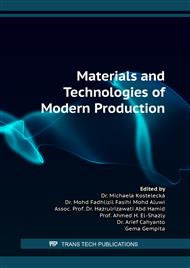[1]
Shao, L., et al., β-Ti Alloys for Orthopedic and Dental Applications: A Review of Progress on Improvement of Properties through Surface Modification. Coatings, 2021. 11: p.1446.
DOI: 10.3390/coatings11121446
Google Scholar
[2]
Petersen, R.C., Titanium Implant Osseointegration Problems with Alternate Solutions Using Epoxy/Carbon-Fiber-Reinforced Composite. Metals, 2014. 4(4): pp.549-569.
DOI: 10.3390/met4040549
Google Scholar
[3]
Ripamonti, U., L.C. Roden, and L.F. Renton, Osteoinductive hydroxyapatite-coated titanium implants. Biomaterials, 2012. 33(15): pp.3813-3823.
DOI: 10.1016/j.biomaterials.2012.01.050
Google Scholar
[4]
Shi, R., et al., Effects of surface roughening and calcite coating of titanium on cell growth and differentiation. Journal of Biomaterials Applications, 2019. 34: pp.088532821-988376.
Google Scholar
[5]
Sunarso, et al., Immobilization of calcium and phosphate ions improves the osteoconductivity of titanium implants. Mater Sci Eng C Mater Biol Appl, 2016. 68: pp.291-298.
DOI: 10.1016/j.msec.2016.05.090
Google Scholar
[6]
Stoch, A., et al., Electrophoretic coating of hydroxyapatite on titanium implants. Journal of Molecular Structure, 2001. 596(1): pp.191-200.
DOI: 10.1016/s0022-2860(01)00716-5
Google Scholar
[7]
Jansen, J.A., et al., Histologic evaluation of the osseous adaptation to titanium and hydroxyapatite-coated titanium implants. Journal of Biomedical Materials Research, 1991. 25(8): pp.973-989.
DOI: 10.1002/jbm.820250805
Google Scholar
[8]
Havelin, L.I., et al., The Norwegian Arthroplasty Register: 11 years and 73,000 arthroplasties. Acta Orthop Scand, 2000. 71(4): pp.337-53.
Google Scholar
[9]
Ishikawa, K., Bone Substitute Fabrication Based on Dissolution-Precipitation Reactions. Materials, 2010. 3(2): pp.1138-1155.
DOI: 10.3390/ma3021138
Google Scholar
[10]
Lucas, A., et al., A synthetic aragonite-based ceramic as a bone graft substitute and substrate for antibiotics. International Journal of Inorganic Materials, 2001. 3(1): pp.87-94.
DOI: 10.1016/s1466-6049(00)00058-1
Google Scholar
[11]
Clarke, S.A., et al., Designs from the deep: Marine organisms for bone tissue engineering. Biotechnology Advances, 2011. 29(6): pp.610-617.
DOI: 10.1016/j.biotechadv.2011.04.003
Google Scholar
[12]
Ahmed, R.A., A.M. Fekry, and R.A. Farghali, A study of calcium carbonate/multiwalled-carbon nanotubes/chitosan composite coatings on Ti–6Al–4V alloy for orthopedic implants. Applied Surface Science, 2013. 285, Part B(0): pp.309-316.
DOI: 10.1016/j.apsusc.2013.08.056
Google Scholar
[13]
Liu, Y., et al., Evaluation of the attachment, proliferation, and differentiation of osteoblast on a calcium carbonate coating on titanium surface. Materials Science and Engineering: C, 2011. 31(5): pp.1055-1061.
DOI: 10.1016/j.msec.2011.03.003
Google Scholar
[14]
Sun, L., et al., Material fundamentals and clinical performance of plasma-sprayed hydroxyapatite coatings: a review. J Biomed Mater Res, 2001. 58(5): pp.570-92.
DOI: 10.1002/jbm.1056
Google Scholar
[15]
Le Thi, B., et al., Biological responses of MC3T3-E1 on calcium carbonate coatings fabricated by hydrothermal reaction on titanium. Biomedical Materials, 2020. 15(3): p.035004.
DOI: 10.1088/1748-605x/ab6939
Google Scholar
[16]
Bang, L.T., et al., Synthesis and assessment of metallic ion migration through a novel calcium carbonate coating for biomedical implants. Journal of Biomedical Materials Research Part B: Applied Biomaterials, 2020. 108(2): pp.429-438.
DOI: 10.1002/jbm.b.34399
Google Scholar
[17]
Koga, N., et al., Effects of humidity on calcite block fabrication using calcium hydroxide compact. Ceramics International, 2015. 41(8): pp.9482-9487.
DOI: 10.1016/j.ceramint.2015.04.005
Google Scholar
[18]
International Organisation for Standardization, Implants for surgery — Hydroxyapatite — Part 2: Thermally sprayed coatings of hydroxyapatite ISO 13779-2:2018, www.iso.org (accessed: June 2021).
Google Scholar
[19]
Somers, N. and M. Lasgorceix, Surface Treatment of Bioceramics, in Encyclopedia of Materials: Technical Ceramics and Glasses, M. Pomeroy, Editor. 2021, Elsevier: Oxford. pp.701-715.
DOI: 10.1016/b978-0-12-818542-1.00032-1
Google Scholar
[20]
Bang, L., et al., Biological responses of MC3T3-E1 on calcium carbonate coatings fabricated by hydrothermal reaction on titanium. Biomedical Materials, 2020. 15.
DOI: 10.1088/1748-605x/ab6939
Google Scholar
[21]
Shi, R., K. Hayashi, and K. Ishikawa, Rapid Osseointegration Bestowed by Carbonate Apatite Coating of Rough Titanium. Advanced Materials Interfaces, 2020. 7(18): p.2000636.
DOI: 10.1002/admi.202000636
Google Scholar
[22]
Ishikawa, K., et al., Fabrication of interconnected porous calcite by bridging calcite granules with dicalcium phosphate dihydrate and their histological evaluation. J Biomed Mater Res A, 2016. 104(3): pp.652-658.
DOI: 10.1002/jbm.a.35604
Google Scholar
[23]
Shi, R., et al., Effects of surface roughening and calcite coating of titanium on cell growth and differentiation. Journal of Biomaterials Applications, 2020. 34(7): pp.917-927.
DOI: 10.1177/0885328219883765
Google Scholar



